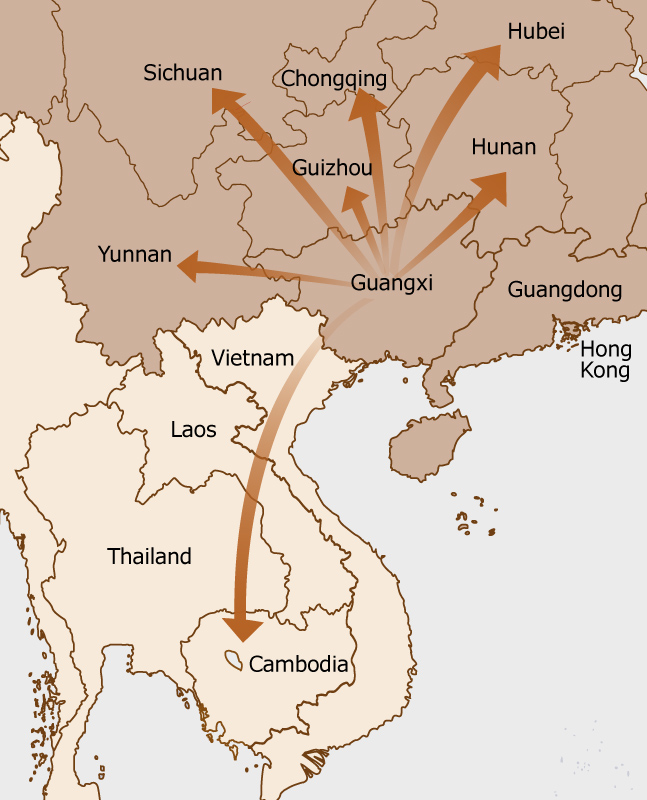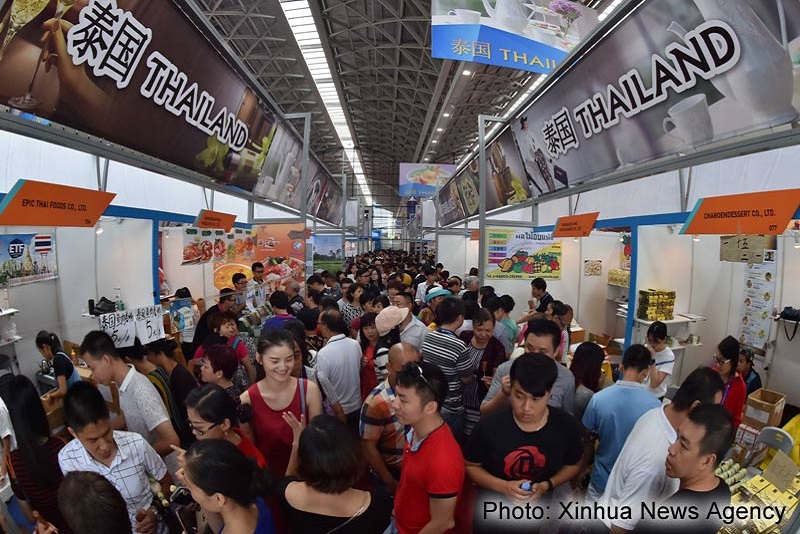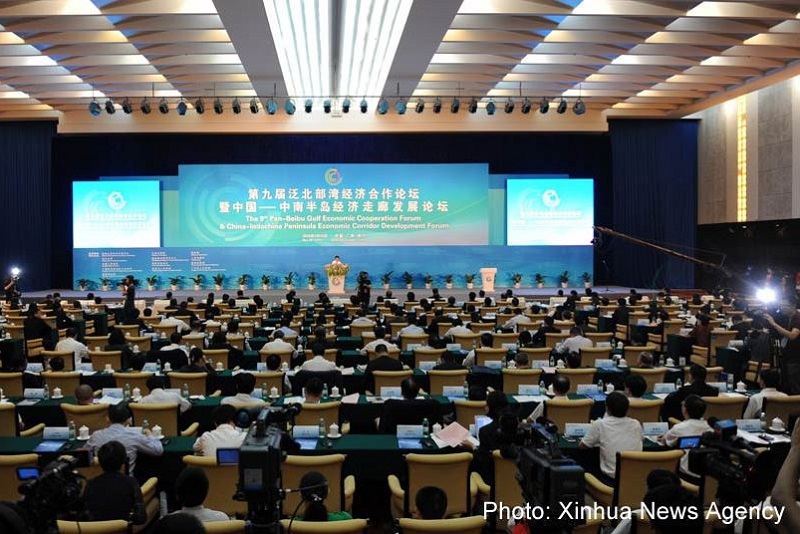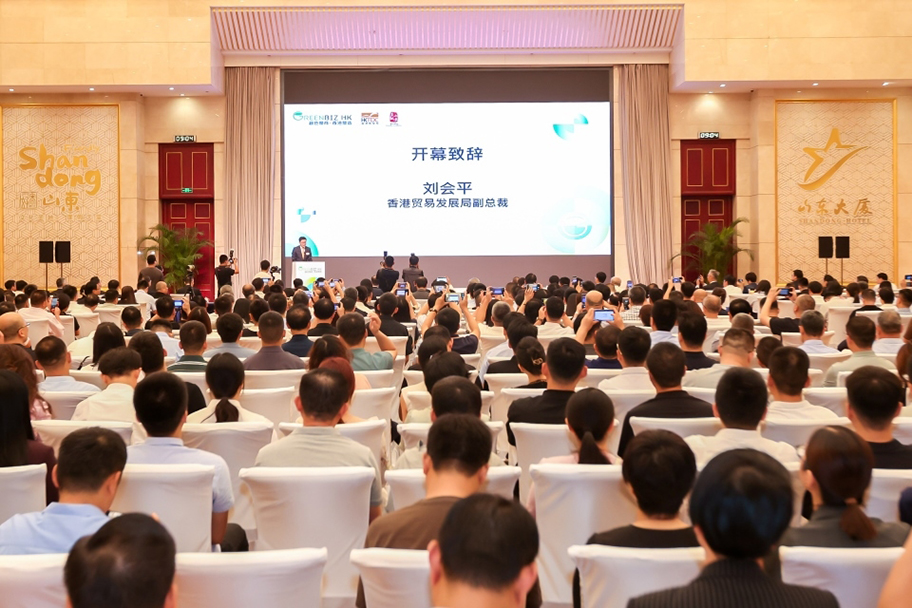Guangxi: Strategic Role in Belt and Road Initiative
Guangxi has a strategic role to play in both the Belt and the Road. The autonomous region’s “four-dimensional support” development strategy includes further opening up to the east with emphasis on strengthening co-operation with Guangdong and Hong Kong, such as forging closer collaboration with Hong Kong’s professional services under the Closer Economic Partnership Arrangement’s (CEPA) early and pilot measures, and encouraging Hong Kong and foreign enterprises to participate in Guangxi’s construction projects in relation to the Belt and Road Initiative, including the China-ASEAN information port as well as transport and logistics facilities serving ASEAN countries. Meanwhile, Guangxi also hopes to co-operate with Hong Kong companies in advancing the two-way development of its enterprises in “going out” and “bringing in”.
Guangxi Spreads Across Both Belt and Road
The Belt and Road Initiative aims to achieve economic policy co-ordination of countries along its routes, and promote the orderly free flow of economic factors, the highly effective distribution of resources, and in-depth market integration. In addition to the large number of countries along the routes that will participate in building the Belt and Road, different provinces, regions and cities in China are also proactively involved in contributing to the initiative.
According to the Vision and Actions on Jointly Building the Silk Road Economic Belt and 21st Century Maritime Silk Road issued by the National Development and Reform Commission (NDRC) in March 2015, in advancing the Belt and Road Initiative, China is to give full play to the comparative advantages of various regions in the country. Vision and Actions pointed out that efforts would be made to “give full play to the unique advantages of Guangxi in regard to its geographical connection with ASEAN countries by land and by sea, expedite the pace of opening up and developing the Beibu Bay Economic Zone and Pearl River-Xijiang Economic Belt, build international passages serving the ASEAN region, create a new strategic stronghold for the opening-up and development of the southwest and central south regions, and develop an important gateway for the organic integration of the 21st Century Maritime Silk Road and the Silk Road Economic Belt”.
Vision and Actions set out three key directions for co-operation in building the Silk Road Economic Belt over land, namely China with Southeast Asia, South Asia, and the Indian Ocean. Meanwhile, the key direction for co-operation in developing the 21st Century Maritime Silk Road by sea is from China’s coastal ports to the Indian Ocean via the South Sea on to Europe, as well as from China’s coastal ports to the South Pacific Ocean via the South Sea.
In terms of geography, Guangxi shares land borders with Vietnam and is situated in a key geographical position in terms of China’s land connections with Southeast Asia. At the same time, the many ports in Guangxi’s Beibu Bay Economic Zone offer much room for the development of sea connections. As such, Guangxi plays a strategic role in both the Belt and the Road.[1]
Strengthening Transport Links Between Inland China and Southeast Asia
Under the development directions of the Belt and Road, Guangxi is expediting its pace of implementing the “four-dimensional support and four-alongs interaction” strategy aimed at strengthening opening up and co-operation internally and externally. The focus of “four-dimensional support” is giving emphasis to the key direction of opening up to the outside world.
First of all, efforts are to be made to further open up to and enhance co-operation with the south, positioning Guangxi as one of the mainland’s contact points in connecting to the Indochina Peninsula. Such efforts also aim to deepen co-operation with ASEAN countries along the Belt and Road, such as building an international co-operation platform and seeking international co-operation in production capacity. With regard to land passages, actions are to be taken to expedite construction of the East Line of the Pan-Asia Railway and highways running from Nanning through Hanoi and Phnom Penh to Bangkok.
Secondly, steps are to be taken to further open up to the east, with emphasis on enhancing collaboration with Guangdong, Hong Kong and Macau, including strengthening co-operation with Hong Kong’s professional services under the CEPA early and pilot measures. Thirdly, efforts are to be made to forge co-operation with important hinterland regions in the southwest and central south (including Yunnan, Guizhou, Sichuan, Chongqing, Hunan and Hubei), and to build passages and establish platforms for these two regions. And fourthly, steps are to be taken to further open up to and strengthen co-operation with developed countries, align with the advanced level of productivity of such developed countries and regions as the EU, Japan and Korea, as well as to further raise the level of internationalisation of Guangxi.
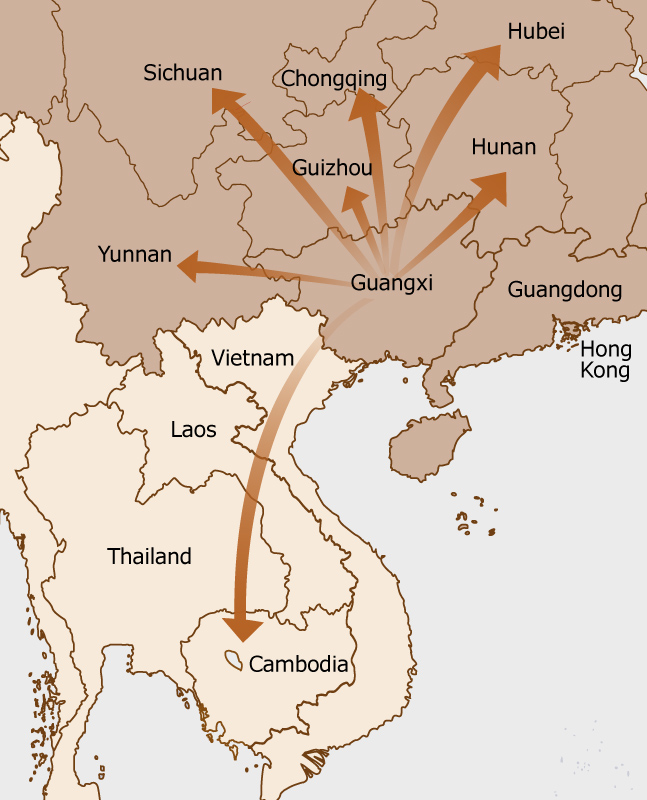
“Four-alongs interaction” refers to the opening up of areas along the sea coast, along the river, along the border, and along the Belt and Road.
Along the sea coast: Guangxi seeks to open up further and expand co-operation along its sea coast, increase the capacity of its ports and their ties with the hinterland, and develop Nanning into an integrated transport hub.
Along the river: Development and co-operation along the river means using the Xijiang golden waterway as the base to expand co-operation between Guangdong and Guangxi, while deepening unified Pan-PRD co-operation.
Along the border: Border trade in Guangxi, with a border of 1,020km, plays an important role in the autonomous region. Efforts will be made to promote collaboration between cross-border economic co-operation zones and advance new development in border areas.
Along the Belt and Road: This refers to the building of expressways and high-speed railways from Guangxi to neighbouring countries along the Belt and Road routes. Capitalising on these transport links, passages for opening up, industrial development and complementariness are to be built. Guangxi has already constructed 13 expressway passages, 11 railway passages and a 2,000-tonne class waterway passage leading to neighbouring provinces and countries.
According to the Guangxi Transport Department, four expressways linking Guangxi with Vietnam have been planned. Indeed, two have already been completed: Nanning to Friendship Gate, and Nanning to Fangchenggang/Dongxing. Meanwhile, construction of the expressways from Baise to Longbang and from Nanning via Chongzuo to Shuikou is under way and both are scheduled for completion by 2019. It is hoped that Vietnam can also accelerate its construction of highways linking to Guangxi.
Drawing on the optimised transport links, Guangxi is actively strengthening its role as the gateway to ASEAN. Since 2016, cargo flows between Guangxi and Thailand have been on the rise. According to the local commerce department, total trade between Guangxi and Thailand grew 32.9% from January to November 2016. Most of the goods were electronic products exported from Thailand to Guangxi by land through Pingxiang for distribution to Yangtze River Delta cities such as Suzhou. In the past, it took about 14 days for goods to be transported from Bangkok to Suzhou by sea, but today it only takes about six days via Guangxi by land. Improvement in trading infrastructure is set to enhance the position of Guangxi as the gateway to ASEAN.
Directions For Co-operation With ASEAN
As an international passage serving ASEAN countries and an important gateway for organic integration, Guangxi plans to forge co-operation with ASEAN in a number of major directions. The potential opportunities provided by the long-term development directions and individual projects for related industries are worth noting.
According to the Guangxi Development and Reform Commission, Nanning, as a regional integrated transport hub, is designated by Guangxi as the core for land connectivity, linking with the Indochina Peninsula to the south and connecting with the Eurasian Land Bridge to the north. With regard to sea connectivity, emphasis is being placed on developing Beibu Bay into a regional shipping centre, as well as building the China-ASEAN port cities co-op network. It is understood that since the China-ASEAN port cities co-op network was built in 2013, 10 new shipping routes have been opened. At the same time, great efforts are being made to advance collaboration in such areas as ports, industry, monitoring, rescue and the judiciary. This has in turn facilitated the flow of people and cargo between China and ASEAN.
In the days to come, the focus of co-operation will be on establishing a shipping and logistics service system, including setting up a regional port logistics technology standardisation system, promoting co-operation in port investment and operation, and deepening collaboration between port industries. At present, Guangxi is quickening its pace in building a network of shipping routes covering 47 port cities in ASEAN countries. Some 35 regular container liners currently sail from Guangxi’s Beibu Bay, establishing marine transport links with ASEAN countries such as Brunei, Indonesia and Malaysia. Where forging closer co-operation in commerce and logistics is concerned, Guangxi attaches importance to promoting the China-ASEAN bulk commodities trading centre, improving the functions of the bonded logistics platform, and developing cross-border e-commerce.
Under the Belt and Road Initiative, strengthening industrial co-operation with regions along the routes is one of the important development directions. In this connection, Guangxi places emphasis on building cross-border industry chains, with priority given to promoting the China-Malaysia Qinzhou Industrial Park in Qinzhou, Guangxi, and the Malaysia-China Kuantan Industrial Park in Kuantan, Malaysia; the China-Indonesia Economic and Trade Co-operation Zone; and the Brunei-Guangxi Economic Corridor; as well as building the China-ASEAN agricultural co-operation base.
Furthermore, actions have been taken to accelerate the pace of building the Guangxi border comprehensive financial reform pilot zone and promoting innovative cross-border renminbi business. There are plans to build the China-ASEAN environmental co-operation demonstration platform and the China-ASEAN environmental technology exchange co-operation base.
Efforts are also being made to further advance construction of the China-Indochina Peninsula Economic Corridor by leveraging such leading co-operation platforms as the China-ASEAN Expo and Pan-Beibu Bay Economic Co-operation Forum. For instance, when the Pan-Beibu Bay Economic Co-operation Forum was held in 2016, the China-Indochina Peninsula Economic Corridor Development Forum and the China-ASEAN Port Cities Co-op Network Work Conference were convened coincidentally. These platforms for co-operation have now become major avenues for political and commercial exchanges with ASEAN.

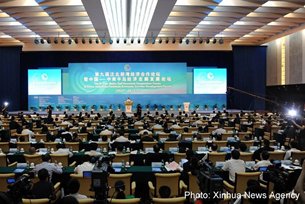
It is worth noting that in 2015, China proposed at the 12th China-ASEAN Expo that a China-ASEAN information port be built. Its aim is to deepen network connectivity and information interflow with a view to creating a China-ASEAN information hub with Guangxi as the fulcrum, as well as promoting online economic and trade services and technological co-operation. Construction work will be carried out in two stages.
First, actions will be taken to build a number of basic projects and plan a number of industrial bases serving ASEAN to form a preliminary framework for the China-ASEAN information port. Then from 2018 to 2020, the China-ASEAN national information communication network system will be built to create a big service platform for infrastructural facilities, technological co-operation, economic and trade services, information sharing, and cultural exchanges. The Guangxi Development and Reform Commission pointed out that the China-ASEAN information port involves more than 100 projects, embracing Asia Pacific international direct dial submarine optical cables, China-Vietnam and China-Myanmar cross-border optical cable system capacity expansion, a cloud computation centre, and a big-data centre. Upon completion, it will form a basic network of information integrating with ASEAN.
Enhancing ASEAN Trade Facilitation
In its efforts to strengthen ties with ASEAN, Guangxi not only gives weight to developing infrastructure such as transport and information networks, but also enhances trade facilitation arrangements, in particular customs clearance facilitation. In order to bring mutual benefits to Guangxi and ASEAN in trade and investment, the autonomous region takes the lead in studying and implementing the “two countries, one inspection” system for customs clearance facilitation with ASEAN countries.
Leveraging its geographical advantage of sharing land borders with Vietnam and the establishment of the China-Malaysia and Malaysia-China industrial parks, and with the support of China’s customs, and inspection and quarantine departments, Guangxi plans to implement the “two countries, one inspection” customs clearance system jointly with Vietnam and Malaysia first. Steps are being taken to introduce the new customs clearance facilitation measure at the China-Vietnam Friendship Gate in Vietnam on a pilot basis.
According to the Guangxi Commerce Department, the autonomous region possesses the right conditions to implement the “two countries, one inspection” customs clearance system on a trial basis in view of the busy flow of people and goods in its border areas. However, implementation of the “two countries, one inspection” system would be easy at first but become more difficult. For land-based trade, in the first stage, plans have been made with Vietnam to conduct concurrent inspection by both countries at the Pingxiang cargo freight passage in 2017. In other words, the two countries are to carry out inspection separately but at the same time and at the same location in the importing country.
In the next stage, the customs offices of the two countries will be located in the same building and all documents required will be unified. As for mutual recognition of standards between the two countries, further study will be conducted. For sea-based trade, the Malaysia-China Kuantan Industrial Park will serve as the pilot and it is planned that whole-journey monitoring of containers of designated products of designated enterprises from designated ports will be carried out and that unilateral inspection at the importing country will be conducted. Since the degree of complexity of this stage is higher, it is likely to be introduced at a later stage.
Prospects of Co-operation with Hong Kong under Belt and Road
Guangxi’s “four-dimensional support” development strategy includes further opening up to the east with emphasis on strengthening co-operation with Guangdong, Hong Kong and Macau. This includes forging closer collaboration with Hong Kong’s professional services under CEPA’s early and pilot measures, and taking advantage of the city’s role as a super middleman to encourage Hong Kong and foreign enterprises to participate in Guangxi’s construction projects in relation to the Belt and Road Initiative, including the China-ASEAN information port and transport and logistics facilities serving ASEAN countries. Guangxi also hopes to co-operate with Hong Kong companies in advancing the two-way development of its enterprises in “going out” and “bringing in” by conducting such activities as joint study missions and exhibitions.
Information released by the Guangxi Development and Reform Commission reveals that from among construction projects related to the Belt and Road Initiative, Guangxi has chosen more than 200 projects calling for close co-operation with foreign parties and has formed a project data bank. It is estimated that total investments involved exceed RMB1.2 trillion. These projects are distributed all over Guangxi and ASEAN countries covering extensive sectors.
Apart from infrastructure, Hong Kong’s industrial sector should pay attention to the development of Guangxi’s co-operation with ASEAN in international production capacity and make use of the room for growth to effectively integrate regional supply chains. In recent years, Guangxi’s electronics industry has been growing in leaps and bounds, and a modern electro-plating industrial park is being planned at Beihai Tieshan Port in a move to support development of the industry.
However, Guangxi’s manufacturing industries are in dire need of professional services – such as R&D, brand promotion and testing – at a higher level to support their growth. Also, Guangxi-ASEAN co-operation in outward investment is looking to international professional enterprises and institutions to provide the necessary legal, accounting and consultancy services, and Hong Kong’s professional service suppliers can provide such services to Guangxi enterprises. As Hong Kong is an international trade platform, Guangxi’s efforts to further strengthen ties with the Indochina Peninsula in commerce and logistics is bound to offer new opportunities to the city’s service providers and traders.
Cross-border financial co-operation also plays a part in Guangxi’s participation in building the Belt and Road. The autonomous region mainly serves as a border comprehensive financial reform pilot zone with a view to advancing co-operation with ASEAN in such areas as cross-border renminbi settlement and exchange, two-way investment, and financial regulation.
As far as building big international passages is concerned, apart from the construction of such hardware as ports and transport infrastructure, the demand for enhancing the necessary international logistics services and management systems is also huge, with cold-chain logistics offering the greatest growth potential. Hong Kong companies should take note of the development opportunities generated by Guangxi in its participation in building the Belt and Road. Furthermore, Guangxi should strengthen information dissemination so that the market can have easy access to the latest information on its development.
[1] In order to find out about the positioning and latest development of Guangxi in the Belt and Road, HKTDC Research visited Nanning, Qinzhou, Beihai, Fangcheng Port and Dongxing in early 2017 with the help of the Guangxi Commerce Department.
